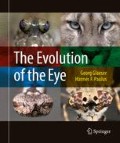Abstract
In 1856, Charles Darwin was the first to formulate a consistent theory of evolution by discovering the main causal factors that produce evolutionary changes in organisms, these being selection and mutation. The variety of individuals in a population provides the raw materials for a selection procedure that results in some individuals being more (and others to be less) successful at reproduction, based on momentary environmental conditions. This changes the genetic makeup of the population that follows – the quintessence of evolution.
Access this chapter
Tax calculation will be finalised at checkout
Purchases are for personal use only
Preview
Unable to display preview. Download preview PDF.
Author information
Authors and Affiliations
Rights and permissions
Copyright information
© 2015 Springer International Publishing Switzerland
About this chapter
Cite this chapter
Glaeser, G., Paulus, H.F. (2015). Pax and homology. In: The Evolution of the Eye. Springer, Cham. https://doi.org/10.1007/978-3-319-17476-1_7
Download citation
DOI: https://doi.org/10.1007/978-3-319-17476-1_7
Publisher Name: Springer, Cham
Print ISBN: 978-3-319-17475-4
Online ISBN: 978-3-319-17476-1
eBook Packages: Biomedical and Life SciencesBiomedical and Life Sciences (R0)

